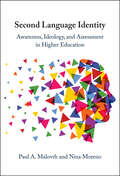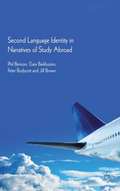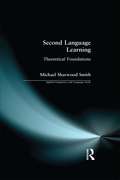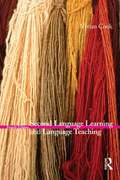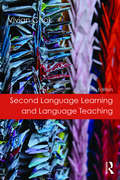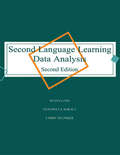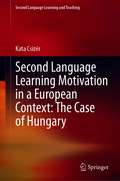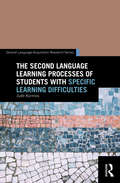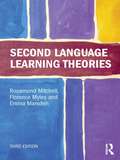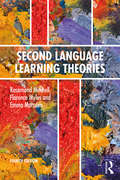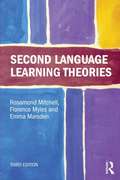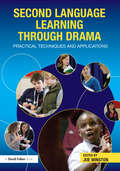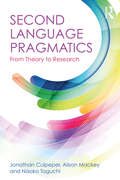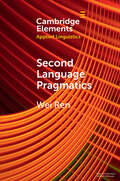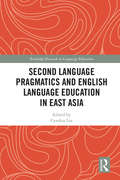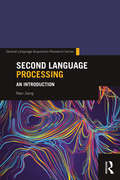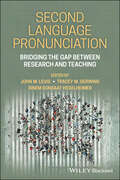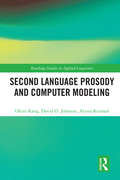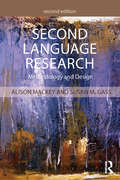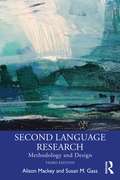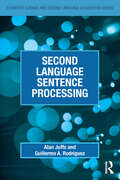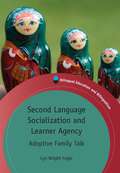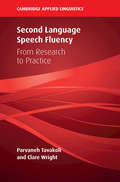- Table View
- List View
Second Language Identity: Awareness, Ideology, and Assessment in Higher Education
by Paul A. Malovrh Nina MorenoIncreasing globalization presents both challenges and opportunities to the higher education sector. This pioneering book shows how interaction between the two fields of foreign language pedagogy and second language acquisition (SLA) can facilitate more effective language development at an advanced level. Establishing a new research agenda to describe, assess, and study high-level language use, it uses mixed-methods analyses within a sociocognitive framework to explore constructs such as second language (L2) identity and critical language awareness as essential components of multilingualism and global citizenship. It approaches L2 advancedness from multiple perspectives, examining the L2 learner and their understanding of advanced language use, highlighting individual differences among foreign-language professionals regarding high-level language use, positing the need for unified departmental missions, and analysing alternative constructs to assess L2 advancedness. Throughout, analyses of quantitative and qualitative data are used to demonstrate the multiple dimensions of advanced second language use in higher education.
Second Language Identity in Narratives of Study Abroad
by Phil Benson Et Al.Study abroad is now both an international industry and an experience that can have a deep impact on students' attitudes and approaches to second language learning. Narratives of Second Language Identity in Study Abroad brings together three important research areas by exploring the impact of study abroad on second language identities through narrative research. It outlines a new model of second language identity that incorporates a range of language and personal competencies. The three main dimensions of this model are explored in chapters that begin with students' study abroad narratives, followed by the authors' in-depth analysis. Further chapters use narratives to assess the impact of programme type and individual difference. Arguing that second language identity development is one of the more important outcomes of study abroad, the book concludes with recommendations on how study abroad programmes can best achieve this outcome.
Second Language Learning: Theoretical Foundations (Applied Linguistics and Language Study)
by Michael Sharwood Smith Christopher N. CandlinA survey and analysis of second language theory discusses the development of ideas in this expanding area of language studies. It looks at the implications of these ideas and directions for future research. Contains study questions and activities as well as practical guidelines on the use of available research resources.
Second Language Learning and Language Teaching
by Vivian CookThe fourth edition of this classic textbook has been revised to reflect recent developments in language teaching and learning yet retains the basic structure and approach so popular with its readers. Teaching and learning content has been updated, particularly taking into account the rise of task-based learning, Conversational Analysis and social models of second language acquisition, changes in national syllabuses and examinations and the increasing controversy over the role of the native speaker target. Each chapter has been revised to stand alone, enabling the text to be taught and studied out of sequence if preferred. A set of focusing questions has also been added to each and further reading sections have been updated. Second Language Learning and Language Teaching remains the essential textbook for all student teachers of modern languages and TESOL as well as applied linguistics.
Second Language Learning and Language Teaching: Fifth Edition
by Vivian CookSecond Language Learning and Language Teaching provides an introduction to the application of second language acquisition research to language teaching. Assuming no previous background in second language acquisition or language teaching methods, this text starts by introducing readers to the basic issues of second language acquisition research. It then examines how people learn particular aspects of the second language, such as grammar, vocabulary, pronunciation and the writing system, and at the strategies they adopt in their learning and the differences between individuals. Final chapters look at second language learning in a broader context – the goals of language teaching and how teaching methods relate to SLA research. This newly updated fifth edition builds on the comprehensive scope of earlier editions while also addressing more recent developments in the field, particularly multilingual approaches to language teaching.
Second Language Learning Data Analysis: Second Edition
by Susan GassThe purpose of this workbook is to provide students with practice in analyzing second language data. For the student of second language learning, "hands-on" experience with actual data is essential in understanding the processes involved in learning a second language. Working through exemplars of the kinds of interlanguages that learners do and do not create brings about a clearer understanding of the principles underlying these interlanguages, as well as the universal principles of language learning (those that are independent of particular languages and interlanguages). The goal in this workbook is to present data organized in such a way that by working through pedagogically presented data-sets, students are led to a discovery and understanding of theoretical and/or methodological issues. In addition, they acquire the ability to interpret data and to begin to draw conclusions from them. The authors intend that students should go from the data to a conclusion that includes a 3-part statement: *what else you should want to know about these data; *why this, specifically, and not something else; and *how one can empirically research what you want to find out. This sequence of questions forces students to constantly keep in mind the important question of falsification: What kind of data would it take to falsify the particular conclusions the students come to? As with the earlier edition of this workbook (Sorace, Gass, & Selinker), two audiocassettes provide language samples for use in the exercises. These cassettes and the teacher's manual are offered free of charge on adoption of the workbook for classroom use; a three-part set (workbook/manual/tapes) is also available.
Second Language Learning Motivation in a European Context: The Case of Hungary (Second Language Learning and Teaching)
by Kata CsizérThis book provides an overview of second language (L2) motivation research in a specific European context: Hungary, which has proved to offer an important laboratory for such research, as a number of major political changes over the past 30 years have created a changing background for L2 learning in an increasingly globalized world. The book provides an overview of theoretical research on L2 motivation, together with detailed information on large-scale L2 motivation studies in Hungary. Further, it presents a meta-analysis of the most important investigations, and qualitative data on teachers’ views regarding success in L2 learning. In turn, the interdisciplinary nature of L2 motivation is taken into account and relevant antecedent constructs to L2 motivation are investigated. Lastly, the book outlines possible future directions for L2 motivation research.
The Second Language Learning Processes of Students with Specific Learning Difficulties (Second Language Acquisition Research Series)
by Judit KormosThe Second Language Learning Processes of Students with Specific Learning Difficulties is the only recent book available to offer a detailed and in-depth discussion of the second language learning processes of students with specific learning difficulties (SpLDs). It summarizes research advances in the fields of cognitive and educational psychology and integrates them with recent studies in the area of second language acquisition (SLA). Thus the book is relevant not only to readers who are particularly interested in the role of specific learning difficulties in learning additional languages, but also to those who would like to understand how individual differences in cognitive functioning influence SLA. The book focuses on four important areas that are particularly relevant for language learners with SpLDs: the processes of SLA in general and the development of reading skills in particular, the effectiveness of pedagogical programs, the assessment of the language competence of students with SpLDs and identifying SpLDs in another language. The book also views learners with SpLDs in their social and educational contexts and elaborates how the barriers in these contexts can affect their language learning processes. This is an excellent resource for language teachers, students, and researchers in the areas of second language acquisition and applied linguistics.
The Second Language Learning Processes of Students with Specific Learning Difficulties (ISSN)
by Judit KormosThe Second Language Learning Processes of Students with Specific Learning Difficulties is the only recent book available to offer a detailed and in-depth discussion of the second language learning processes of students with specific learning difficulties (SpLDs). It summarizes research advances in the fields of cognitive and educational psychology and integrates them with recent studies in the area of second language acquisition (SLA). Thus the book is relevant not only to readers who are particularly interested in the role of specific learning difficulties in learning additional languages, but also to those who would like to understand how individual differences in cognitive functioning influence SLA. The book focuses on four important areas that are particularly relevant for language learners with SpLDs: the processes of SLA in general and the development of reading skills in particular, the effectiveness of pedagogical programs, the assessment of the language competence of students with SpLDs and identifying SpLDs in another language. The book also views learners with SpLDs in their social and educational contexts and elaborates how the barriers in these contexts can affect their language learning processes. This is an excellent resource for language teachers, students, and researchers in the areas of second language acquisition and applied linguistics.
Second Language Learning Theories
by Rosamond Mitchell Florence Myles Emma MarsdenSecond Language Learning Theories is a clear and concise overview of the field of second language acquisition (SLA) theories. Written by a team of leading academics working in different SLA specialisms, this book provides expert analysis of the main theories from multiple perspectives to offer a broad and balanced introduction to the topic. The book covers all the main theoretical perspectives currently active in the SLA field and sets them in a broader perspective per chapter, e.g. linguistic, cognitive or sociolinguistic. Each chapter examines how various theories view language, the learner, and the acquisition process. Summaries of key studies and examples of data relating to a variety of languages illustrate the different theoretical perspectives. Each chapter concludes with an evaluative summary of the theories discussed. This third edition has been thoroughly updated to reflect the very latest research in the field of SLA. Key features include: a fully re-worked chapter on cognitive models of language and language learning a new chapter on information processing, including the roles of different types of memory and knowledge in language learning the addition of a glossary of key linguistic terms to help the non-specialist a new timeline of second language learning theory development? This third edition takes account of the significant developments that have taken place in the field in recent years. Highly active domains in which theoretical and methodological advances have been made are treated in more depth to ensure that this new edition of Second Language Learning Theories remains as fresh and relevant as ever.
Second Language Learning Theories: Fourth Edition
by Rosamond Mitchell Florence Myles Emma MarsdenSecond Language Learning Theories is a clear and concise overview of the field of second language acquisition (SLA) theories. Written by a team of leading academics working in different SLA specialisms, this book provides expert analysis of the main theories from multiple perspectives to offer a broad and balanced introduction to the topic. The book covers all the main theoretical perspectives currently active in the SLA field and sets them in a broader perspective per chapter, e.g. linguistic, cognitive or sociolinguistic. Each chapter examines how various theories view language, the learner, and the acquisition process. Summaries of key studies and examples of data relating to a variety of languages illustrate the different theoretical perspectives. Each chapter concludes with an evaluative summary of the theories discussed. This third edition has been thoroughly updated to reflect the very latest research in the field of SLA.
Second Language Learning Theories
by Rosamond Mitchell Florence Myles Emma MarsdenSecond Language Learning Theories provides a clear and concise overview of the field of second language acquisition (SLA) theories. Written by a team of leading academics working in different SLA specialisms, this book provides expert analysis of the main theories from multiple perspectives to offer a broad and balanced introduction to the topic. The book covers all the main theoretical perspectives currently active in the SLA field and sets them in a broader perspective per chapter, e. g. linguistic, cognitive or sociolinguistic. Each chapter examines how the various theories view language, the learner and the acquisition process. Summaries of key studies and examples of data relating to a variety of languages illustrate the different theoretical perspectives. Each chapter concludes with an evaluative summary of the theories discussed. This third edition has been thoroughly updated to reflect the very latest research in the field of SLA. Key features include: * A fully re-worked chapter on cognitive models of language * A new chapter on information processing, including language production and comprehension * The addition of a glossary of key linguistic terms to help the non-specialist * A new timeline of second language learning theory development. This third edition takes account of the significant developments that have taken place in the field in recent years. Highly active domains in which theoretical and methodological advances have been made are treated in more depth to ensure that this new edition of Second Language Learning Theoriesremains as fresh and relevant as ever.
Second Language Learning through Drama: Practical Techniques and Applications
by Joe WinstonDrama is increasingly being recognised as a valuable pedagogy for language learning as it can harness children‘s imaginations and stimulate their desire to communicate. Second Learning Language through Drama draws on current theories of additional and foreign language learning and illustrates through practical case studies how drama can be used to support the four key skills of listening, speaking, reading and writing. Drawing on the work of an international group of practitioners who are all highly experienced in using drama for the purpose of second language learning, the book clearly explains key drama conventions and strategies and outlines the innovative ways they have been used to create enjoyable and stimulating classroom activities that allow for multiple ways of learning. Throughout the book the emphasis is on making language learning accessible and relevant to children and young people through creative, physically active and playful approaches. The strategies described are all highly flexible and readily adaptable to different teaching contexts. Specific themes include: Using stories and drama to motivate learners at all levels Drama, language learning and identity Assessment opportunities through process drama Issues of language learning and cultural empowerment Digital storytelling Film & drama aesthetics Second Language Learning through Drama will be of great interest to those studying on undergraduate and postgraduate courses and will serve as a highly valuable text to practitioners looking to incorporate the approaches described into their lessons and classroom activities.
Second Language Pragmatics: From Theory to Research
by Jonathan Culpeper Alison Mackey Naoko TaguchiSecond Language Pragmatics: From Theory to Research aims to reinvigorate this field, pointing the way forward to new methodologies that can drive, or be driven by, new theoretical developments. With a unique combination of leading international expertise in general pragmatics, L2 pragmatics, and research methodology, the authors describe in detail the methods, including the most recent techniques, by which pragmatics of all types can be pursued in L2 contexts. This volume argues that L2 pragmatics research needs to expand from its initial base by drawing from a wider range of sources, such as Corpus Linguistics and Psycholinguistics. Clear, accessible, and practical, Second Language Pragmatics will be valuable to novice and seasoned researchers alike in second language pragmatics, general pragmatics, and second language acquisition courses.
Second Language Pragmatics (Elements in Applied Linguistics)
by Wei RenThis Element introduces the areas that second language (L2) pragmatics research has investigated. It begins with a theme-based review of the field with respect to L2 pragmatics learning, teaching, and assessing. The section on pragmatics learning examines studies on learners' pragmatic production and perception, and analyzes research modalities in this field. The section on pragmatics teaching examines the effects of and different approaches to L2 pragmatics instruction; and the section on pragmatics assessing examines the aspects involved in testing learners' pragmatic competence, and studies on issues related to validity and rating in pragmatics assessing. The Element then analyzes studies exploring learners' cognitive processes during pragmatic performance, and case studies are provided to showcase two ongoing projects, one investigating advanced learners' self-praise on social media and the other investigating lingua franca pragmatics among children. Finally, the Element offers some topics and questions for future research in L2 pragmatics.
Second Language Pragmatics and English Language Education in East Asia (Routledge Research in Language Education)
by Cynthia LeeThis edited collection addresses the link between second language pragmatics (including interlanguage and intercultural) research and English language education. The chapters use different contemporary research methods and theoretical frameworks such as conversation analysis, language-learners-as-ethnographers, discourse and interactional approaches and data in contexts (either in the region or overseas). The content explores and discusses the significance of learning and teaching of second language (L2) pragmatics in language education for learners who use English as a lingua franca for academic and intercultural communication purposes with native and non-native speakers of English, focusing on pragmatic actions, social behaviours, perceptions and awareness levels in three regions in East Asia – China, Japan and South Korea. It is an important contribution to the area of second language pragmatics in language education for East Asian learners. It recommends research-informed pedagogies for the learning and teaching of interlanguage or intercultural pragmatics in regions and places where similar cultural beliefs or practices are found. This is an essential read for researchers, language educators, classroom teachers, readers who are interested in second language pragmatics research and those interested in second language acquisition and English language education in the East Asian context.
Second Language Processing: An Introduction (Second Language Acquisition Research Series)
by Nan JiangSecond Language Processing: An Introduction is the first textbook to offer a thorough introduction to the field of second language processing (SLP). The study of SLP seeks to illuminate the cognitive processes underlying the processing of a non-native language. While current literature tends to focus on one topic or area of research, this textbook aims to bring these different research strands together in a single volume, elucidating their particularities while also demonstrating the relationships between them. The book begins by outlining what is entailed in the study of SLP, how it relates to other fields of study, and some of the main issues shared across its subareas. It then moves into an exploration of the three major areas of current research in the field—phonological processing, lexical processing, and sentence processing. Each chapter provides a broad overview of the topic and covers the major research methods, models, and studies germane to that area of study. Ideal for students and researchers working in this growing field, Second Language Processing will serve as the go-to guide for a complete examination of the major topics of study in SLP.
Second Language Pronunciation: Bridging the Gap Between Research and Teaching
by John M. Levis Tracey M. Derwing Sinem Sonsaat-HegelheimerPractical resources designed to help language educators apply the latest research and most effective pedagogical methods to classroom pronunciation instruction In Second Language Pronunciation: Bridging the Gap Between Research and Teaching, a team of distinguished researchers and educators delivers an incisive and practical approach to evidence-based pronunciation instruction in second language classrooms. Developed for language teachers who want to incorporate and implement the most effective pedagogical methods in their language instruction, this edited volume offers 15 essays that connect the latest research with practical applications in the classroom. In addition to exploring recent but less well-known methods—like High Variability Phonetic Training, discourse-based teaching, communicative classrooms, and technology-based methods—these chapters are unified in bringing theory to bear on practical questions faced by language teachers. The chapters follow a standard format, moving from critical research issues to pedagogical implications, and practical resources to equip language teachers, scholars, administrators, and teachers-in-training with the tools they require to develop their students’ pronunciation abilities. Readers will also find: A thorough introduction to using empirical evidence to guide pronunciation instruction in second language students Comprehensive explorations of the integration of pronunciation instruction into second language education Practical discussions of perception training in pronunciation instruction and the importance of L2 segmental and suprasegmental contrasts in pronunciation learning In-depth examinations of classroom research for pronunciation and the use of technology to explore L2 pronunciationPerfect for upper-level undergraduate and graduate students studying TESOL, applied linguistics, and second language acquisition, Second Language Pronunciation: Bridging the Gap Between Research and Teaching will also earn a place in the libraries of researchers, scholars, and teachers of language and education.
Second Language Prosody and Computer Modeling (Routledge Studies in Applied Linguistics)
by Okim Kang David O. Johnson Alyssa KermadThis volume presents an interdisciplinary approach to the study of second language prosody and computer modeling. It addresses the importance of prosody’s role in communication, bridging the gap between applied linguistics and computer science. The book illustrates the growing importance of the relationship between automated speech recognition systems and language learning assessment in light of new technologies and showcases how the study of prosody in this context in particular can offer innovative insights into the computerized process of natural discourse. The book offers detailed accounts of different methods of analysis and computer models used and demonstrates how these models can be applied to L2 discourse analysis toward predicting real-world language use. Kang, Johnson, and Kermad also use these frameworks as a jumping-off point from which to propose new models of second language prosody and future directions for prosodic computer modeling more generally. Making the case for the use of naturalistic data for real-world applications in empirical research, this volume will foster interdisciplinary dialogues across students and researchers in applied linguistics, speech communication, speech science, and computer engineering.
Second Language Research: Methodology and Design
by Alison Mackey Susan M. GassIn this second edition of the best-selling Second Language Research, Alison Mackey and Sue Gass continue to guide students step-by-step through conducting the second language research process with a clear and comprehensive overview of the core issues in second language research. Supported by a wealth of data examples from actual studies, the book examines questions of what is meant by research and what defines good research questions, covering such topics as basic research principles and data collection methods, designing a quantitative research study, and concluding and reporting research findings. The second edition includes a new chapter on mixed-methods, new "time to think" and "time to do" text boxes throughout, and updates to reflect the latest research and literature. Supplementary materials, including an extensive glossary and appendices of forms and documents that students can use in conducting their own studies, serve as useful reference tools, with suggestions on how to get research published reemphasizing the book’s practical how-to approach. Second Language Research, Second Edition is the ideal resource for understanding the second language research process for graduate students in Second Language Acquisition and Applied Linguistics.
Second Language Research: Methodology and Design
by Alison Mackey Susan M. GassSecond Language Research: Methodology and Design is a clear, comprehensive overview of core issues in L2 research. Authored by well-known scholars in SLA and supported by a wealth of examples from actual studies and extensive pedagogical resources, this book first introduces students to the key topics and debates in L2 research. It then guides readers step by step through the research process—from basic principles and collection methods through study design and reporting—to the point of being able to conduct their own research from beginning to end. This book is an essential text for students and novice researchers of SLA, applied linguistics, and second and foreign language teaching. Key Features A wealth of graphics, visuals, and exercises in each chapter. "Time to Think" and "Time to Do" boxes within chapters Helpful glossary and subject index New to This Edition Substantially reorganized chapters Significantly expanded chapters on qualitative and mixed methods Substantive revised material on computer/technology-based research Spotlights a variety of new software packages and databases, including video-mediated technology and games Discusses the Open Science Movement Expanded coverage of corpora, processing, and psycholinguistics-based research Updated references throughout
Second Language Sentence Processing (Cognitive Science and Second Language Acquisition Series)
by Alan Juffs Guillermo A. RodríguezThis addition to the Cognitive Science and Second Language Acquisition series presents a comprehensive review of the latest research findings on sentence processing in second language acquisition. The book begins with a broad overview of the core issues of second language sentence processing research and then narrows its focus by dedicating individual chapters to each of these key areas. While a number of publications have discussed research findings on knowledge of formal syntactic principles as part of theories of second language acquisition, there are fewer resources dedicated to the role of second language sentence processing in this context. This volume will act as the first full-length literature review of the field on the market.
Second Language Socialization and Learner Agency
by Lyn Wright FogleThis book examines how Russian-speaking adoptees in three US families actively shape opportunities for language learning and identity construction in everyday interactions. By focusing on a different practice in each family (i.e. narrative talk about the day, metalinguistic discourse or languaging, and code-switching), the analyses uncover different types of learner agency and show how language socialization is collaborative and co-constructed. The learners in this study achieve agency through resistance, participation, and negotiation, and the findings demonstrate the complex ways in which novices transform communities in transnational contexts. The perspectives inform the fields of second language acquisition and language maintenance and shift. The book further provides a rare glimpse of the quotidian negotiations of adoptive family life and suggestions for supporting adoptees as young bilinguals.
Second Language Speech
by Colantoni, Laura and Steele, Jeffrey and Escudero, Paola Laura Colantoni Jeffrey Steele Paola EscuderoSecond language acquisition has rapidly grown as a field over the past decade, as our knowledge of the ways in which children and adults learn and use a second language has become crucial for effective language teaching. In addition to this important 'applied' function, research into second language acquisition has also informed the fields of linguistics and psychology in general, as it has shed light on the differences between native and non-native models of human language and cognition. The focus of this accessible new book is second language speech - that is, how speakers perceive, process, understand and pronounce the sounds of a second language. Each chapter includes review questions, and most chapters include 'tutorial' and 'lab' sections with practical exercises based on the University of Toronto Romance Phonetics Database (available online for free). The book also has a companion website, containing illustrated answers to the exercises, scripts for running acoustic analyses and useful weblinks.
Second Language Speech Fluency: From Research to Practice (Cambridge Applied Linguistics)
by Parvaneh Tavakoli Clare WrightSecond language (L2) fluency is an exciting and fast-moving field of research, with clear practical applications in language teaching. This book provides a lively overview of the current advances in the field of L2 fluency, and connects the theory to practice, presenting a hands-on approach to using fluency research across a range of different language-related professions. The authors introduce an innovative multidisciplinary perspective, which brings together research into cognitive and social factors, to understand fluency as a dynamic variable in language performance, connecting learner-internal factors such as speech processing and automaticity, to external factors such as task demands, language testing, and pragmatic interactional demands in communication. Bringing a much-needed multidisciplinary and novel approach to understanding the complex nature of L2 speech fluency, this book provides researchers, students and language professionals with both the theoretical insights and practical tools required to understand and research how fluency in a second language develops.
